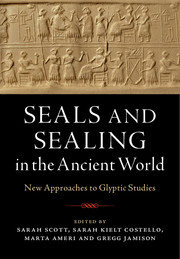 Seals and Sealing in the Ancient World
Seals and Sealing in the Ancient World Book contents
- Seals and Sealing in the Ancient World
- Seals and Sealing in the Ancient World
- Copyright page
- Contents
- Notes on Contributors
- Illustrations
- Plates
- Tables
- Acknowledgments
- Preface
- Abbreviations
- Chapter One Introduction: Small Windows, Wide Views
- Part I The Ancient Near East and Cyprus
- Part II South Asia and the Gulf Region
- Part III Egypt
- Part IV Aegean
- References
- Endnotes
- Index
Part III - Egypt
Published online by Cambridge University Press: 24 April 2018
- Seals and Sealing in the Ancient World
- Seals and Sealing in the Ancient World
- Copyright page
- Contents
- Notes on Contributors
- Illustrations
- Plates
- Tables
- Acknowledgments
- Preface
- Abbreviations
- Chapter One Introduction: Small Windows, Wide Views
- Part I The Ancient Near East and Cyprus
- Part II South Asia and the Gulf Region
- Part III Egypt
- Part IV Aegean
- References
- Endnotes
- Index
Summary
Sealing technology first appears in Egypt around 3600 BCE during the Naqada II period of the Predynastic. Thereafter, the use of seals undergoes a lengthy evolution, responding to the shifting structure of the country’s political system, as well as changes in cultural, religious, and artistic traditions that spanned some three millennia. This chapter will provide a comprehensive, typological overview of the evolution in seal forms (including cylinders, stamps, scarabs, and other specialized seal forms) and iconography, and discuss continuities and discontinuities that characterize Egyptian sealing traditions. Here we will examine the evolving modes of seal usage, both as administrative tools and as artifacts that expressed a wider suite of religious and cultural aspects of Egyptian society. Particularly valuable in the Egyptian record is the rich textual source material which illuminates the ways seals and sealing systems related to functioning administrative systems. The following discussion will enmesh the physical evidence within a selection of relevant ancient documentary sources. This review of sealing traditions in Egypt will include a case study. In the context of the present discussion the Abydos case study will be used to illustrate methodologies and issues in the recovery, analysis, and interpretation of seals and sealings in the Egyptian archaeological record.
- Type
- Chapter
- Information
- Seals and Sealing in the Ancient WorldCase Studies from the Near East, Egypt, the Aegean, and South Asia, pp. 227 - 324Publisher: Cambridge University PressPrint publication year: 2018


